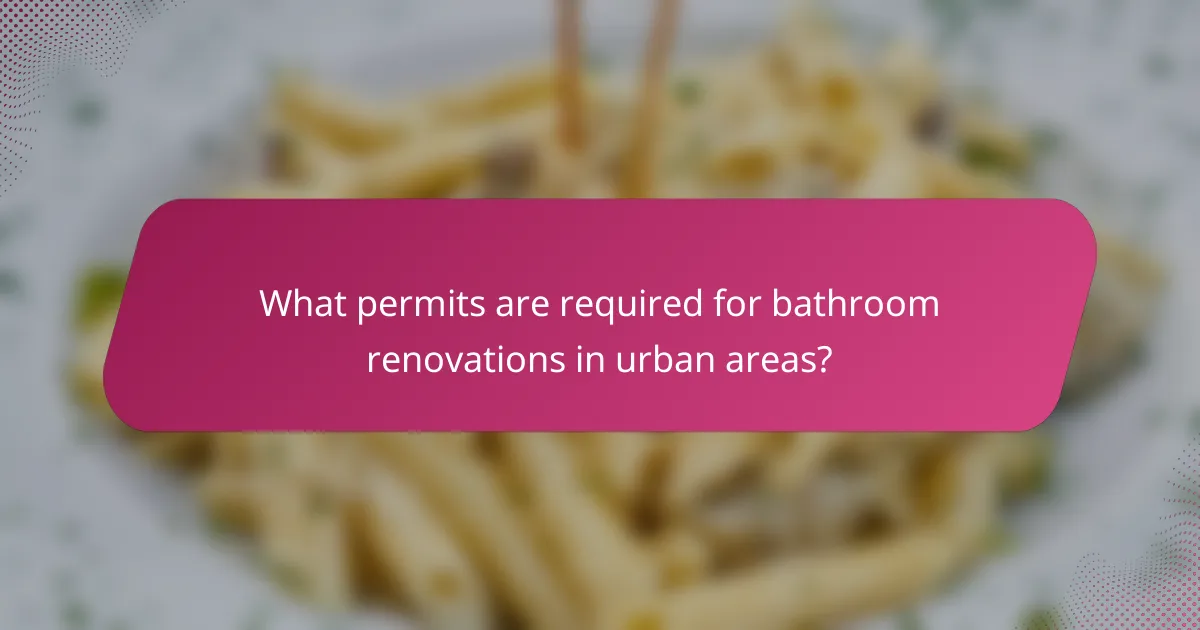Renovating a bathroom in urban areas can be a significant investment, with costs ranging from several thousand to tens of thousands of dollars based on project size and complexity. Key factors such as material quality, labor expenses, and local market conditions play a crucial role in determining the overall price. By understanding these elements and setting a clear budget, homeowners can navigate the renovation process more effectively and make informed choices.

What are the average bathroom renovation costs in urban areas?
In urban areas, average bathroom renovation costs typically range from several thousand to tens of thousands of dollars, depending on the size and complexity of the project. Factors such as materials, labor, and local market conditions significantly influence these costs.
Cost range for small bathrooms
For small bathrooms, renovation costs generally fall between $5,000 and $15,000. This range often includes basic updates like new fixtures, tiles, and paint, but can increase with higher-end materials or custom features.
When budgeting for a small bathroom renovation, consider prioritizing essential upgrades, such as plumbing and electrical work, to ensure functionality while keeping costs manageable.
Cost range for medium bathrooms
Medium bathroom renovations typically range from $10,000 to $25,000. This budget allows for more extensive changes, such as replacing bathtubs, adding storage solutions, and upgrading lighting fixtures.
To optimize your budget, focus on a balance between aesthetics and functionality. Investing in durable materials can save money in the long run by reducing the need for future repairs or replacements.
Cost range for large bathrooms
Large bathroom renovations can cost anywhere from $20,000 to $50,000 or more. This price range accommodates significant alterations, including layout changes, luxury fixtures, and high-end finishes.
When planning a large bathroom renovation, it’s crucial to work with experienced professionals who can help design a space that meets your needs while adhering to local building codes and regulations. Consider creating a detailed plan to avoid unexpected expenses during the renovation process.

What factors influence bathroom renovation pricing?
Bathroom renovation pricing is influenced by several key factors, including material quality, labor costs, and design complexity. Understanding these elements can help homeowners budget effectively and make informed decisions during the renovation process.
Material quality
The quality of materials used in a bathroom renovation significantly affects the overall cost. High-end materials such as natural stone tiles, custom cabinetry, and luxury fixtures can drive prices up, while more affordable options like laminate or vinyl can help keep costs down.
When selecting materials, consider both durability and aesthetics. Investing in quality materials may lead to longer-lasting results and less frequent replacements, ultimately saving money in the long run.
Labor costs
Labor costs can vary widely based on location, contractor experience, and the complexity of the work involved. In urban areas, labor rates tend to be higher, often ranging from 50 to 150 USD per hour, depending on the skill level required.
To manage labor expenses, obtain multiple quotes from contractors and verify their credentials. It’s essential to balance cost with quality to ensure the work meets your expectations.
Design complexity
The complexity of the bathroom design plays a crucial role in determining renovation costs. Simple updates, such as replacing fixtures or repainting, are generally less expensive than extensive remodels that involve structural changes or custom layouts.
When planning your renovation, consider the layout and any potential obstacles. A straightforward design can help minimize costs, while intricate designs may require additional labor and materials, increasing the overall budget.

How can I budget for a bathroom renovation?
To budget for a bathroom renovation, start by determining your overall spending limit based on your financial situation and the scope of the project. Consider all costs, including materials, labor, and unexpected expenses, to create a comprehensive budget.
Setting a realistic budget
Setting a realistic budget involves assessing the average costs of bathroom renovations in your area. Typically, a mid-range bathroom remodel can range from several thousand to tens of thousands of dollars, depending on the size and complexity of the project.
Break down your budget into categories such as fixtures, cabinetry, flooring, and labor. This will help you allocate funds more effectively and identify areas where you may want to splurge or save.
Allocating funds for unexpected expenses
When budgeting for a bathroom renovation, it’s wise to set aside a contingency fund for unexpected expenses, which can arise during the project. A common recommendation is to reserve about 10-20% of your total budget for these unforeseen costs.
Unexpected issues can include plumbing problems, mold remediation, or structural repairs. Being prepared for these surprises will help you avoid financial strain and keep your renovation on track.
Comparing quotes from contractors
Comparing quotes from contractors is crucial for ensuring you get the best value for your renovation. Obtain at least three quotes to understand the market rates and services offered.
When reviewing quotes, look beyond the total price. Consider the scope of work, materials included, and the contractor’s reputation. Check reviews and ask for references to gauge their reliability and quality of work.

What are common financing options for bathroom renovations?
Common financing options for bathroom renovations include home equity loans, personal loans, and credit card financing. Each option has its own benefits and considerations, making it important to evaluate which best fits your financial situation and renovation needs.
Home equity loans
Home equity loans allow homeowners to borrow against the equity they have built in their property. Typically, these loans offer lower interest rates compared to other financing options, as they are secured by the home itself. Borrowers can generally access a portion of their home’s value, often ranging from 80% to 90% of the equity.
When considering a home equity loan, be mindful of the closing costs and the potential impact on your home’s marketability. Ensure that your renovation plans will add value to your home that exceeds the cost of the loan.
Personal loans
Personal loans are unsecured loans that can be used for various purposes, including bathroom renovations. These loans typically have higher interest rates than home equity loans but do not require collateral, making them accessible to a wider range of borrowers. Loan amounts can vary widely, often from a few thousand to tens of thousands of dollars.
Before opting for a personal loan, compare interest rates and terms from different lenders. Look for loans with no prepayment penalties, allowing you to pay off the loan early without incurring additional fees.
Credit card financing
Credit card financing can be a quick way to fund bathroom renovations, especially for smaller projects. Many credit cards offer introductory 0% APR periods, which can help manage costs if you can pay off the balance within that timeframe. However, interest rates can be high once the promotional period ends.
Using credit cards for renovations requires careful budgeting to avoid accumulating debt. It’s advisable to limit spending to what you can afford to pay off each month, and consider the total cost of financing if you plan to carry a balance beyond the introductory period.

What permits are required for bathroom renovations in urban areas?
In urban areas, bathroom renovations typically require several permits to ensure compliance with local building codes and safety regulations. These permits vary by city but generally include building, electrical, and plumbing permits.
Building permits
Building permits are essential for any structural changes in your bathroom, such as moving walls or altering the layout. They ensure that the renovation adheres to safety standards and local zoning laws.
To obtain a building permit, you usually need to submit detailed plans of your renovation to the local building department. Fees for these permits can range from a few hundred to several thousand dollars, depending on the complexity of the project.
Electrical permits
Electrical permits are required when you plan to install or modify electrical systems in your bathroom, including lighting, outlets, or wiring. These permits help ensure that all electrical work meets safety standards to prevent hazards.
When applying for an electrical permit, you may need to provide specifications for the electrical work and possibly have it inspected after completion. Costs for electrical permits can vary, but they are generally in the low hundreds of dollars.
Plumbing permits
Plumbing permits are necessary for any changes to the plumbing system, such as installing new fixtures or relocating pipes. These permits help ensure that the work complies with health and safety regulations.
To secure a plumbing permit, you will typically need to submit plans and may require inspections during and after the work. Fees for plumbing permits can also range from a few hundred to over a thousand dollars, depending on the scope of the renovations.

How long does a bathroom renovation typically take?
A bathroom renovation usually takes anywhere from a few days to several weeks, depending on the scope of the project. Minor updates can be completed quickly, while major renovations require more time for planning, demolition, and installation.
Timeline for minor renovations
Minor renovations, such as updating fixtures, painting, or replacing tiles, typically take about one to two weeks. This timeframe includes planning, purchasing materials, and the actual work. Homeowners can often manage these projects with minimal disruption.
To expedite the process, consider scheduling work during off-peak times or using pre-fabricated materials. Always ensure that you have all necessary permits, as some local regulations may require them even for minor updates.
Timeline for major renovations
Major renovations, which may involve reconfiguring the layout, plumbing, or electrical systems, can take four to eight weeks or more. This extended timeline accounts for detailed planning, obtaining permits, and coordinating various contractors.
To avoid delays, create a comprehensive project plan and set a realistic budget. Be prepared for unexpected issues, such as hidden water damage, which can extend the timeline. Regular communication with contractors can help keep the project on track and within budget.


